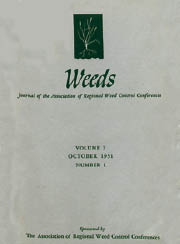Crossref Citations
This article has been cited by the following publications. This list is generated based on data provided by
Crossref.
Agbakoba, Chuma S. O.
and
Goodin, J. R.
1969.
Effect of Stage of Growth of Field Bindweed on Absorption and Translocation of14C-Labeled 2,4-D and Picloram.
Weed Science,
Vol. 17,
Issue. 4,
p.
436.
Hodgson, J. M.
1970.
The Response of Canada Thistle Ecotypes to 2,4-D, Amitrole, and Intensive Cultivation.
Weed Science,
Vol. 18,
Issue. 2,
p.
253.
Bell, Allyn R.
Nalewaja, John D.
and
Schooler, A. B.
1972.
Response of Kochia Selections to 2,4-D, Dicamba, and Picloram.
Weed Science,
Vol. 20,
Issue. 5,
p.
458.
Mohandas, T.
and
Grant, W. F.
1972.
CYTOGENETIC EFFECTS OF 2,4-D AND AMITROLE IN RELATION TO NUCLEAR VOLUME AND DNA CONTENT IN SOME HIGHER PLANTS.
Canadian Journal of Genetics and Cytology,
Vol. 14,
Issue. 4,
p.
773.
Schooler, A. B.
Bell, A. R.
and
Nalewaja, John D.
1972.
Inheritance of Siduron Tolerance in Foxtail Barley.
Weed Science,
Vol. 20,
Issue. 2,
p.
167.
HALLMÉN, ULF
and
ELIASSON, LENNART
1972.
Translocation and Complex Formation of Picloram and 2,4‐D in Wheat Seedlings.
Physiologia Plantarum,
Vol. 27,
Issue. 2,
p.
143.
Hodgson, J. M.
1973.
Lipid Deposition on Leaves of Canada Thistle Ecotypes.
Weed Science,
Vol. 21,
Issue. 3,
p.
169.
Bell, A. R.
Nalewaja, John D.
Alam, S.
Schooler, A. B.
and
Hsieh, T. S.
1973.
Herbicide Response and Morphology of Interspecific Sowthistle Crosses.
Weed Science,
Vol. 21,
Issue. 3,
p.
189.
Harvey, R. G.
and
Muzik, T. J.
1973.
Effects of 2,4-D and Amino Acids on Field Bindweed in Vitro.
Weed Science,
Vol. 21,
Issue. 2,
p.
135.
ELLIS, M.
and
KAY, Q. O. N.
1975.
Genetic variation in herbicide resistance in scentless mayweed (Tripleurospermum inodorum (L.) Schultz Bip.) II. Intraspeciffc variation in response to ioxynil and MCPA, and the role of spray retention characteristics.
Weed Research,
Vol. 15,
Issue. 5,
p.
317.
McNEILL, J.
1976.
The taxonomy and evolution of weeds.
Weed Research,
Vol. 16,
Issue. 6,
p.
399.
Young, James A.
and
Evans, Raymond A.
1976.
Responses of Weed Populations to Human Manipulations of the Natural Environment.
Weed Science,
Vol. 24,
Issue. 2,
p.
186.
West, L. D.
Muzik, T. J.
and
Witters, R. E.
1976.
Differential Gas Exchange Responses of Two Biotypes of Redroot Pigweed to Atrazine.
Weed Science,
Vol. 24,
Issue. 1,
p.
68.
Richard, E. P.
and
Baker, J. B.
1979.
Response of Selected Rice (Oryza sativa)Lines to Molinate.
Weed Science,
Vol. 27,
Issue. 2,
p.
219.
Werner, G. M.
and
Putnam, A. R.
1980.
Differential Atrazine Tolerance Within Cucumber (Cucumis sativus).
Weed Science,
Vol. 28,
Issue. 2,
p.
142.
Donald, W. W.
Parke, R. V.
and
Shimabukuro, R. H.
1982.
The effects of diclofop‐methyl on root growth of wild oat.
Physiologia Plantarum,
Vol. 54,
Issue. 4,
p.
467.
Oka, H.-I.
and
Morishima, Hiroko
1982.
Biology and ecology of weeds.
p.
73.
Rosenthal, S. S.
and
Buckingham, G. R.
1982.
Natural enemies ofConvolvulus arvensisin western Mediterranean Europe.
Hilgardia,
Vol. 50,
Issue. 2,
p.
1.
Smith, Albert E.
1983.
Differential Bahiagrass (Paspalum notatum) Cultivar Response to Atrazine.
Weed Science,
Vol. 31,
Issue. 1,
p.
88.
Degennaro, Francis P.
and
Weller, Stephen C.
1984.
Growth and Reproductive Characteristics of Field Bindweed (Convolvulus arvensis) Biotypes.
Weed Science,
Vol. 32,
Issue. 4,
p.
525.

